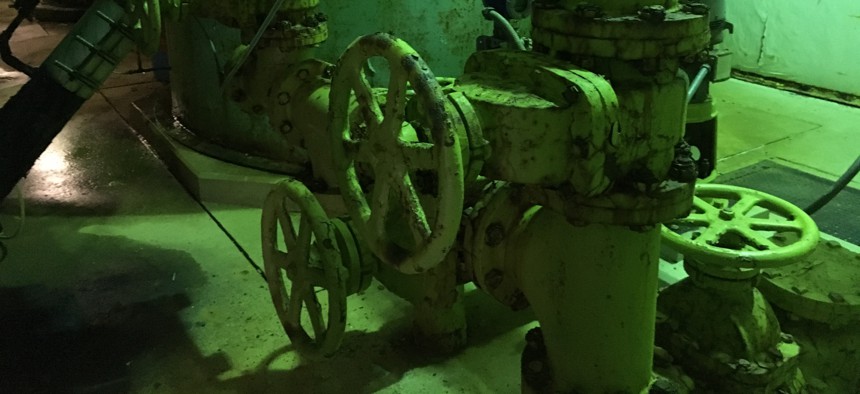House and Senate Lawmakers Look to Boost Water and Sewer Financing

Aging pipes and valves at a water treatment plant near Pocahontas, Virginia Route Fifty / Bill Lucia
Sen. John Boozman, an Arkansas Republican, says new legislation is meant to help communities "of all sizes, in every state secure loans so they can improve their crumbling infrastructure."
WASHINGTON — States could gain new access to federal funding to provide low-cost loans for water and sewer projects under a pair of companion bills introduced last week on Capitol Hill.
Lawmakers described the bipartisan legislation as a way to combine beneficial parts of two existing federally-backed financing programs for drinking water and wastewater infrastructure: state revolving funds and the Water Infrastructure Finance and Innovation Act, or WIFIA.
The new bills in the House and Senate would authorize $200 million annually over five years to support state revolving fund projects.
“We have a more than $500 billion shortfall for water infrastructure funding in this country. This is a national emergency,” said Sen. John Boozman, an Arkansas Republican and the Senate bill's lead sponsor.
“This legislation is an innovative approach to helping communities of all sizes, in every state secure loans so they can improve their crumbling infrastructure," he added.
With clean water and drinking water revolving fund programs, the Environmental Protection Agency awards “capitalization grants” to states, and states contribute a 20 percent match.
States use the funds to provide low-cost loans and other types of financing assistance for water and wastewater utilities to complete projects. As borrowers repay loans, the principal and interest flows back into the revolving funds and can be used for further lending.
Congress established the WIFIA pilot program in 2014. It involves the federal government lending directly for water projects at interest rates aligned with the typically low rates for U.S. Treasury debt. Eligible borrowers include states, localities, corporations, and joint ventures—although private entities need a public sponsor to access the program.
Beyond low interest rates, WIFIA borrowers stand to benefit from perks that have to do with the timeframe for repaying loans.
Lawmakers gave both EPA and the Army Corps of Engineers authority to set up similar WIFIA lending programs for different types of projects. EPA said last year it was inviting 12 entities, with projects in nine states, to apply for more than $2 billion in loans.
Proponents of WIFIA see the program as a way for the federal government to subsidize water infrastructure investments without putting a sizable dent in the nation’s budget.
But critics say that, compared to the revolving funds, WIFIA shifts power from states to the federal level when it comes to deciding which projects get financing assistance. Some also question WIFIA's special focus on bigger and costlier water projects, when many needed upgrades around the U.S. involve smaller systems.
The bills introduced last week would effectively extend WIFIA lending terms to the state revolving funds, so that states could offer revolving fund loans, with Treasury interest rates, for water and wastewater projects that they’ve determined to be priorities.
Mike Keegan works on regulatory and legislative affairs for the National Rural Water Association. “I'm arguing that, really, it’d be preferable for all the money that’s being used to fund WIFIA to be dedicated to the Boozman bill,” he said. “We’re not there yet.”
"But what I think is happening now," he added, "is people are starting to understand the argument better and saying: 'well, if my state has the same financial authorities that’s in WIFIA, to do what WIFIA does, why wouldn't I want the funding going to my state, where they get to fund what they want, as opposed to giving it to EPA?”
Under the new legislation, states that receive under 2 percent of the total state revolving fund grants made available in a fiscal year, and states hit by presidentially declared disasters, would be able to access loans at interest rates that are even lower than the Treasury rate.
There are also provisions in the bill to encourage states to bundle projects, including one that would waive a $100,000 application fee.
Reps. John Katko, a New York Republican, and Earl Blumenauer, an Oregon Democrat, offered the House legislation.
Sens. Cory Booker, a New Jersey Democrat, Jim Inhofe, an Oklahoma Republican, and Dianne Feinstein, a California Democrat, joined Boozman in introducing the Senate version.
Boozman chairs the Environment and Public Works subcommittee on fisheries, water and wildlife.
President Trump has indicated that upgrading the nation’s infrastructure is one of his priorities. In his State of the Union address last week he called for a package that would generate $1.5 trillion of total investment, incorporating federal, state, local and private dollars.
White House officials have said the administration is supportive of a plan that would involve about $200 billion of direct federal funding for infrastructure over a decade. But where the federal money for this level of spending would come from remains unclear.
Bill Lucia is a Senior Reporter for Government Executive's Route Fifty and is based in Washington, D.C.
NEXT STORY: Sidewalk Labs' transit platform offers APIs for parking, tolls data






